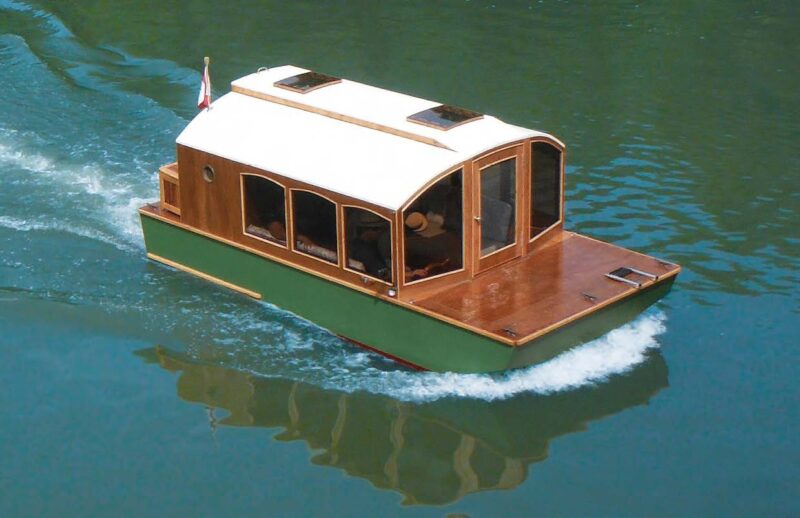 John Summers
John SummersAfter Dianne Schreyer told her husband she’d spend more time on the water if they had a more stable boat, Roy built DIANNE’S ROSE. The couple are on the water all the time now.
If you’re like most people, you probably enjoy relaxing in your living room, and why wouldn’t you? The furniture is comfortable, you can put your feet up at the end of a long day, and there are always snacks and beverages close by. If you can imagine having all this, enjoying nice scenery moving gently by outside the windows and having a pleasant breeze blowing through, you’ll know what it feels like to go for a cruise on DIANNE’S ROSE, Roy Schreyer’s charming 17′ houseboat. A day with Roy and Dianne on their boat resembles nothing so much as taking your living room out on the water with you.
After years of beach cruising in a modified Star-class sailboat that he rescued from a farm field, Roy responded to a comment from his wife, Dianne, that a more stable boat would get her out on the water more often, and so he designed and built DIANNE’S ROSE. Roy calls his new cruiser a house/camp boat, and he and Dianne find that DIANNE’S ROSE is equally comfortable on the water or on the trailer in a campground on the way to the water. He professes a fondness for near-shore, shallow-water adventures, sliding under bridges and going as far up the creek as he can before running out of water (and, according to Dianne, even a little farther on occasion), and in this small boat he has created an ideal platform for these kinds of adventures.
This is a big little boat, and every inch of the interior volume is available for use. Because there are no side decks, the cabin is almost 7′ 6″ wide. Even with the decks at the bow and stern, it is still 10′ long inside. The designer has made good use of the basic construction of the hull to support the interior functions. The hull is a barge with a flat-bottomed center section and a garboard plank on each side that rises through 6″ of deadrise to form a chine at the waterline. In profile the bottom sweeps up to make a pram bow, and the full-width transom is slightly raked.
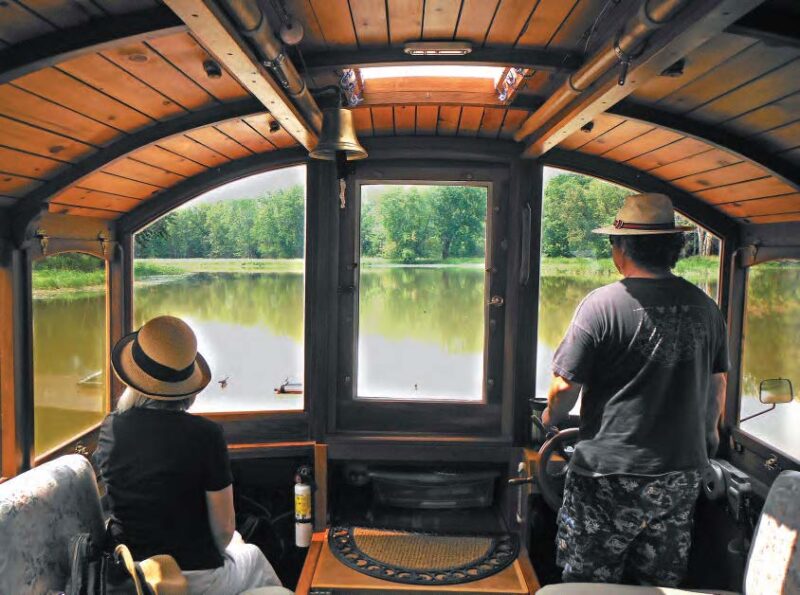 John Summers
John SummersThe arched roof of the cabin adds to the feeling of spaciousness in the cabin as Roy and a passenger enjoy the view of the Nottawasaga River in Wasaga Beach, Ontario.
Construction is common lumber and marine ply-wood covered with epoxy and fiberglass cloth. The main hull components can all be built on a flat bench before being assembled, and with the hull being rectangular in plan there are very few curves to deal with in layout and assembly. Joints are mechanically fastened and filleted with epoxy, and the housetop is sheathed with fiberglass cloth and painted white to reflect heat.
Two full-length longitudinal bulkheads built from plywood with lumber doublers on the edges make up the basic egg-crate structure of the hull and also define the cabin layout. The space between the two bulkheads creates the central sole and makes up the edges of the settees. Because these two bulkheads continue fore and aft under the end decks, they provide out-of-the-way stowage for the table in its lowered position. Other filler pieces slide fore and aft on these bulkheads, and when locked into place with deadbolts they offer a step up and out onto the deck at bow and stern. At the stern, the bulkheads define the galley cupboard and the head area, and their interior faces are nicely finished with raised-panel wainscoting to add some decorative appeal.
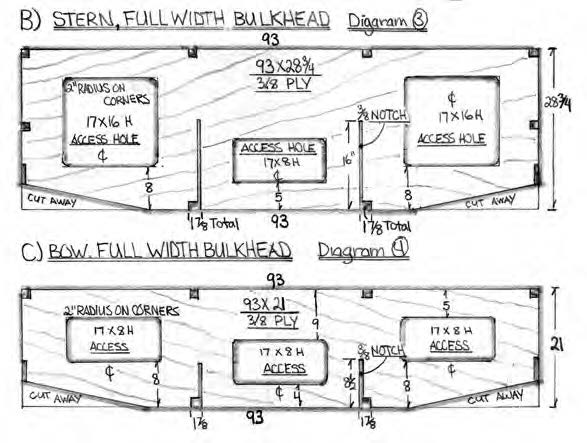 John Summers
John SummersRoy Schreyer’s 21 pages of plans include detailed drawings of every piece on DIANNE’S ROSE, along with directions and images of each step of construction.
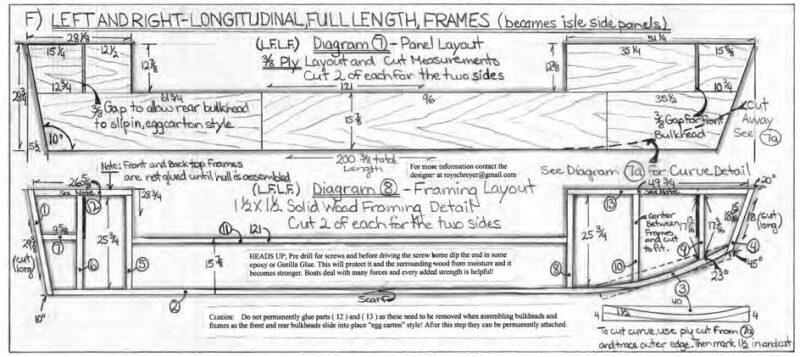 John Summers
John SummersParticulars
LOA 17′ 0″
Beam 8′ 0″
Draft 6″
Interior height 6′ 91⁄2″
Displacement 1,500 lbs empty
Power 9.9-hp to 50-hp outboard
It is at the forward end of the accommodation that Roy has done his best design work. The settees stop short of the forward end of the house, leaving a foot-well for the captain (to starboard) and first mate (to port). The view forward and to either side is panoramic, and even on a short cruise I could see how these are best seats in the house. With the window removed and a screen inserted in the doors to the deck at bow and stern, there is a delightful through-breeze on even the hottest of days. When we were out on the river, the boat was covered in deerflies, and yet we were perfectly cool and comfortable inside the bright, airy cabin. A small afterdeck houses the motorwell and two tidy wooden deck boxes, one for gas and one for propane for the galley stove.
When the settees are used for sleeping, one of the back cushions on each side covers the well to make up the length required for two fore-and-aft berths. In a nice bit of design work, these same two filler pieces can also be placed between the settees to form a transverse queen-size berth.
With its longitudinal tongue-and-groove planking and raised center section, the overhead was inspired by old railway cars. Two skylights keep the interior bright, and if one were so inclined chocks could be fitted port and starboard for a dinghy or a little canoe, and maybe a couple of steel-shod setting poles for really-shallow-water work. Roy has recently added a pair of oars, which mount to oarlocks on the forward sides of the house, for low-speed (or out-of-gas) maneuvering, and these too stow neatly inside the cabin along with the fishing rods on either side of the raised center section of the overhead.
The galley has a small sink with a water pump and a two-burner propane stove that can also be dismounted and used outside. Stowage shelves above and below the counter, and an opening window in the aft bulk-head, complete a very functional little space. The head is equipped with a composting toilet, its own portlight, and, of course, a magazine rack stocked with boating publications. A transverse line of hooks in the overhead allows the entire aft section to be converted into a private bathing and changing room. In keeping with Roy’s thrifty free-cycling approach to boatbuilding, the galley shelving and stove were salvaged from an uncompleted Phil Bolger Martha Jane sharpie, the galley tile was left over from their kitchen renovations, and the aluminum-framed screens for the doors at the bow and stern were cut down from old screen doors.
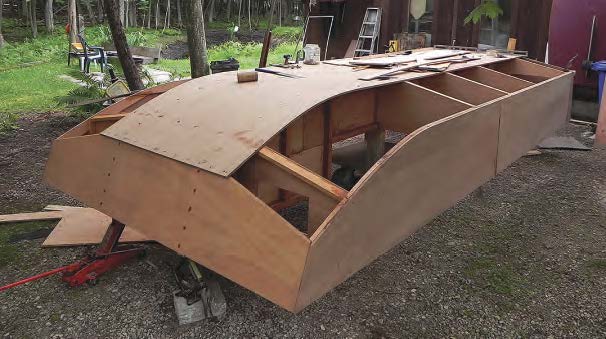 Roy Schreyer
Roy Schreyer Roy Schreyer built the hull from common lumber and marine plywood. The divisions between the bulkheads form flotation compartments and space for stowing gear.
How does she handle? Well, like a barge, really, and about how you would expect a boat to handle that’s virtually flat-bottomed and almost half as wide as long. There are four metal-shod runners on the bottom of the hull to protect against abrasion during beaching. Extending about 1½” below the bottom, they probably improve the tracking somewhat, but I still felt the want of a skeg to keep her on course. Turns are best accomplished by applying a small degree of helm and then meeting the turn with opposite helm almost as soon as it’s started, lest you overcorrect. On your first trip, you’ll want to leave some space on either side of you until your wake straightens out. Roy’s boat is powered with a 9.9-hp longshaft two-stroke outboard, which will give about 6 knots at three-quarters to four-fifths throttle, according to the GPS.
Although it’s unquestionably good on gas, this little outboard works awfully hard to push nearly a ton of boat through the water, and as a result it is distractingly noisy underway. If I were to build one of these boats, I would be inclined to up the horsepower to 25 or 30 and run the motor throttled way back to keep the noise down. I’d also want to find a high-thrust, low-speed prop and, if the budget would stand it, upgrade to a four-stroke for quieter and more efficient running. A wooden hood over the outboard might cut the noise down even further. Even with a larger motor, however, this will still be a very economical boat to run, particularly if she lives on a trailer in your driveway when she’s not on the water. Her decks are clear fore and aft, and a boarding ladder at the bow helps to get back on from the beach. I might add a low bulwark at the bow to give the hull a little bit of sheer in profile and some protection from chop. This would also give you a secure place to stow the anchor and let you keep the docklines out of the cabin. The boarding ladder works well, but it might be even more fun to have a cross-cleated plank to deploy for a real riverboat feel during bow-on landings.
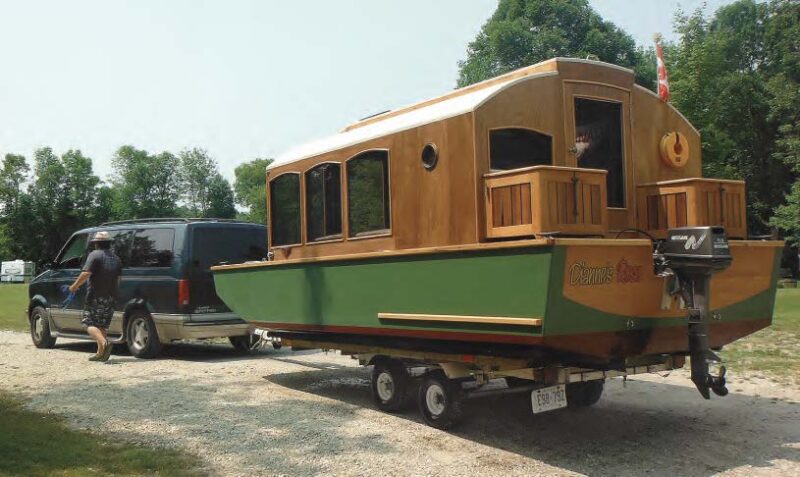 John Summers
John SummersDIANNE’S ROSE is under 8’ wide, weighs about 1,500 lbs empty, and can be towed by the average six-cylinder family utility vehicle.
DIANNE’S ROSE measures 17′ LOA × 8′ beam, and draws but 6″. There’s 6′ 91⁄2″ of headroom in the center alleyway of the cabin, and her air draft is only 7′, allowing her to pass safely under all but the lowest of bridges (if, of course, the captain remembers to lower the flagstaff). Empty weight is 1,500 lbs, and she can be towed behind an average six-cylinder vehicle. With her shallow draft, launching and retrieval can be handled by one person if necessary. The angled outer edges of the bottom help get her centered on the trailer. Both times I saw Roy launch and retrieve, she came out of the water perfectly arranged on the trailer, though he was honest enough to say that it doesn’t always happen that way. If she does need to be shifted while on the trailer after retrieving, a small jack and a couple of boards will get her aligned properly.
The original boat was completed in about 700 hours, spread over two years of weekends working outdoors from spring to fall. Roy estimates that with the comprehensive plans he has now prepared, the boat could be completed in about 600 hours. Costs are always difficult to estimate because they depend so much on the degree of fit, finish, and quality that suits an individual builder, but according to Roy he spent about $5,000 on DIANNE’S ROSE, including the trailer but not the motor.
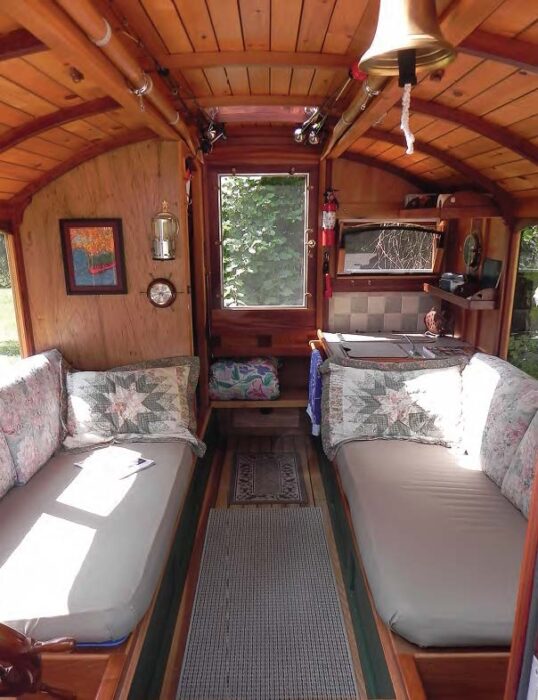 Roy Schreyer
Roy Schreyer The cabin contains two large comfortable settees for use underway.
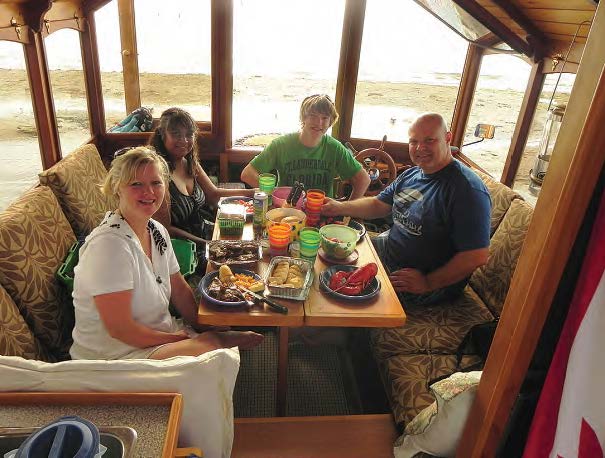 Roy Schreyer
Roy Schreyer At mealtime the convertible table will seat the whole family.
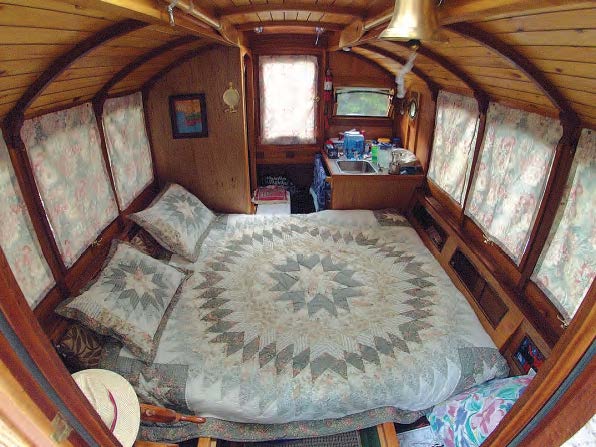 Roy Schreyer
Roy Schreyer In the evening, the settees transform into a queen-size bed.
If you are looking for a charming, easy-to-build, and relatively economical way to get on the water, and a sure-fire way to start a conversation at every gas station, rest stop, campground, or launch ramp you visit, then DIANNE’S ROSE might be the boat for you.
You can read more about the design and construction of DIANNE’S ROSE, see designer and builder Roy Schreyer’s cabinetmaking and kitchen design work, and order plans on his website at www.roydesignedthat.com or by emailing him at [email protected]. If you enjoy small, cozy spaces that you can build yourself, be sure to check out both the Tiny House blog at http://tinyhouseblog.com/ and Lloyd Kahn’s new book Tiny Homes on the Move: Wheels and Water, which features DIANNE’S ROSE.
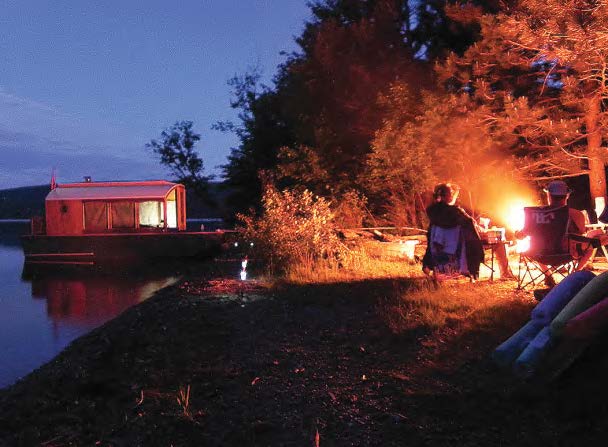 Roy Schreyer
Roy Schreyer Roy and Dianne enjoy camp-cruising at its best with DIANNE’S ROSE beached beside their campsite.
Complete building plans, including 21 sheets of drawings, detailed construction notes, photos, and full-sized patterns for some parts are available as hard copy ($285 USD plus postage) or PDF ($230 USD) from the designer, as are study plans ($30 USD, $35 USD overseas). Send a check or money order to Roy A. Schreyer, 177 Antigua Dr., Wasaga Beach, ON, L9Z 2S2, Canada.
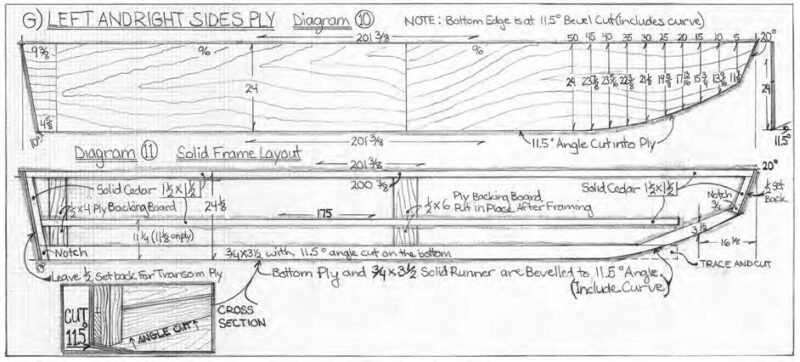
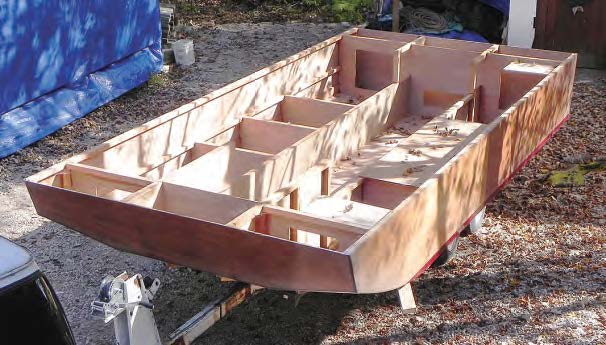
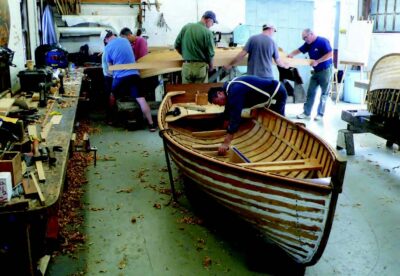
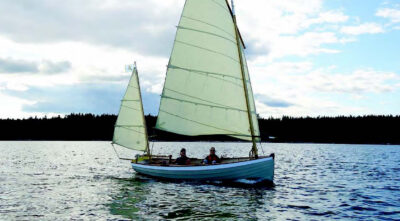

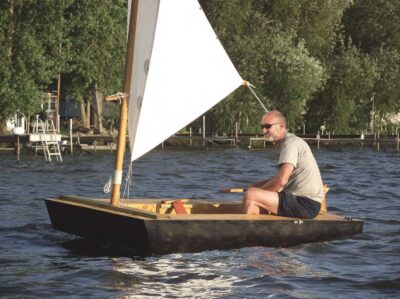
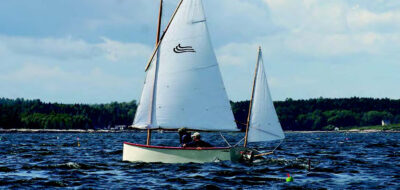
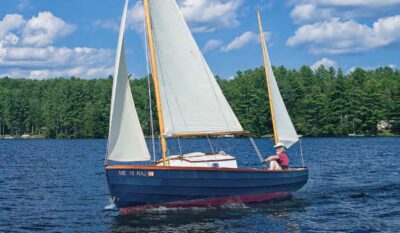
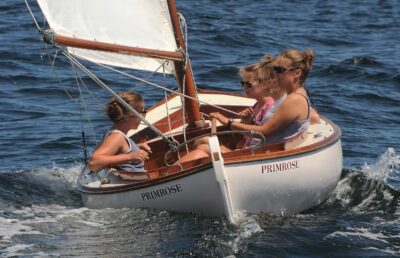
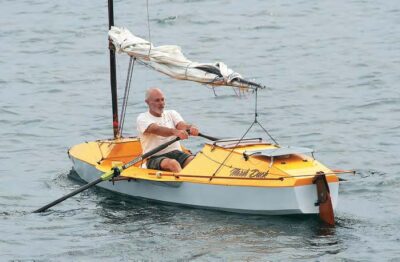
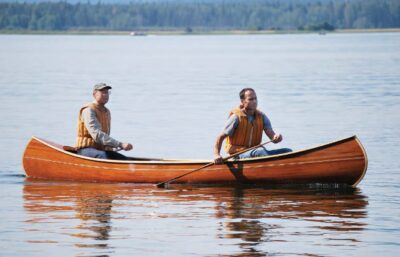
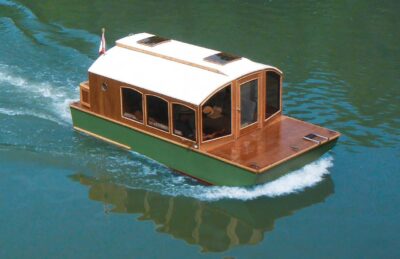


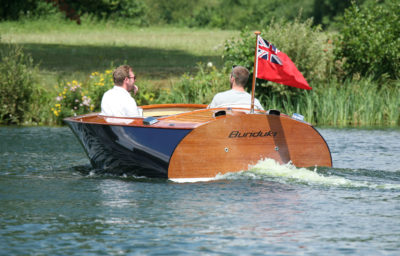
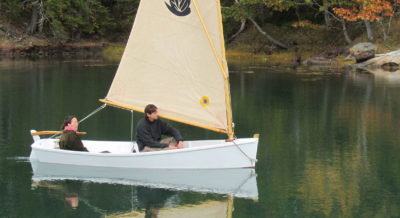
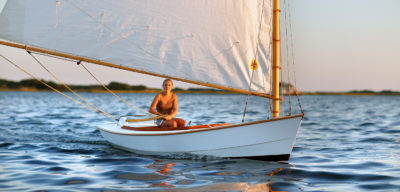
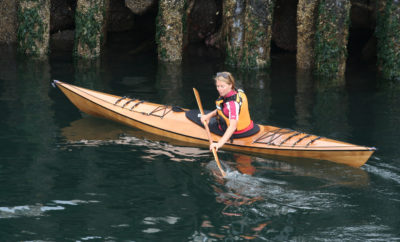
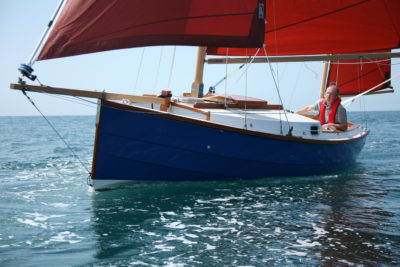
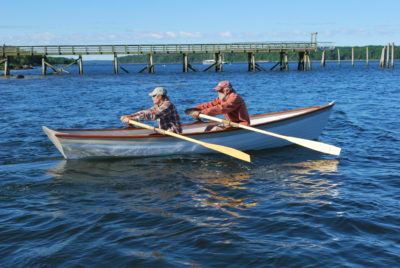
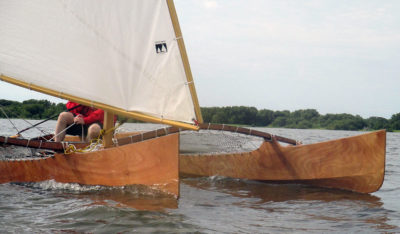
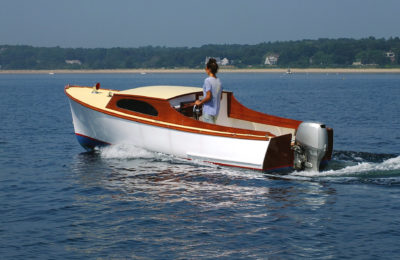
Join The Conversation
We welcome your comments about this article. If you’d like to include a photo or a video with your comment, please email the file or link.